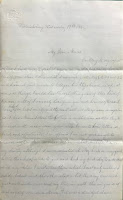 This week we had the opportunity to visit a local 5th-grade classroom via Zoom to talk with them about the American Civil War. The students looked at and analyzed an image from Gardner's Sketch Book of the Civil War, read a military map that provided information about Corinth, Mississippi, and interpreted a personal letter written by a Union soldier, Ransom F. Sargent, to his wife Maria.
This week we had the opportunity to visit a local 5th-grade classroom via Zoom to talk with them about the American Civil War. The students looked at and analyzed an image from Gardner's Sketch Book of the Civil War, read a military map that provided information about Corinth, Mississippi, and interpreted a personal letter written by a Union soldier, Ransom F. Sargent, to his wife Maria.Sargent was a Fife Major of the 11th New Hampshire regiment, Company F, and was in his mid-twenties when he joined the army. His letters home to Maria are a wonderful firsthand account of several important battles that Sargent witnessed, including the disastrous Battle of Fredricksburg, the Siege of Vicksburg, and the Siege of Petersburg. Despite the seriousness of his situation, Sargent also discussed smaller and more personal issues in his letter, including news about other New Hampshire men that he knew and comments about what was going on back in New London, New Hampshire, where Maria awaited his return.

For the 5th-grade class, we both transcribed and provided color scans of a letter he wrote outside Fredericksburg, Virginia, on December 17, 1862. In the letter, Sargent reflects on the recent loss by the Union, saying to Maria: "I long to know what the papers say about this battle. Believe me if they call it anything but a terrible slaughter and defeat into the bargain they very much misrepresent the matter. If ever the works behind Fredricksburg are taken it must be done by some strategy. It never can be taken by storm as last Saturday’s battle proves which cost New Hampshire the lives of more brave and true men than the whole of theaccursed South is worth in my opinion."
Soon after the loss at Fredricksburg, Burnside was relieved of his command by President Abraham Lincoln and replaced by Joseph Hooker. Despite the embarrassment of this demotion, Burnside went on to have a successful political career; was elected to the governorship of Rhode Island after the war and concluded as well as serving as the first president of the National Rifle Association in 1871.
To read more letters by Ransom Sargent to his wife Maria, come to Rauner and ask to see MS-38.

